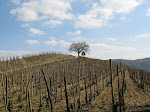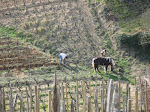Since hearing about Verset's retirement, a feeling of depression had been creeping over the Syrah portion of my brain (roughly 20%). Then, while reading John Livingstone-Learmonth's book The Wines of the Nothern Rhone, I came across a profile on a producer named Dumien-Serrette. Speaking about the owner of the domaine, Gilbert Serrette, Mr. Livingstone-Learmonth wrote that, "he speaks of his traditional methods with pride...vinification is traditional: full bunches, stalks included, are foot crushed, and then there is up to three weeks in neat concrete vats." Perhaps there was one last hold out in Cornas.

The village of Cornas seen from the Patou vineyard.
Back in March, before heading up to Burgundy, myself and two other business colleagues stopped by Cornas to visit Domaine Dumien-Serrette. Before leaving for France, my wife had warned me that I was not packing warm enough clothing for the trip. Sure enough, the spring jacket I brought along was near useless in the windy, 30 degree weather we encountered in the northern Rhone. After some chilly introductions at the front door of the family home in the center of town, we walked down a narrow road and entered the winery. The first piece of equipment to greet us was a giant wooden press. I had assumed that the press, like at most wineries, was there just for decoration. Gilbert explained, much to my surprise, that this was the current press for the winery. The estates entire production fit into one room, which was small. Used barrrels (2-15 years old) lined each wall, and the wine contained in each was a fragrant mix of black olives and dark fruits. In the mouth, these opaque wines were beautifully elegant with soft tannins.

The following notes were taken during our visit to the estate:
1- Cornas, 2007 (barrel sample) - Nice, deep color. Black fruits on the nose and in the mouth. Long, penetrating flavors.
2- Cornas, 2006 - Black color. Silky and long in the mouth. Excellent wine.
3- Cornas, 2005 - Black color. Elegant, pure nose. Black fruits in the mouth with big, firm tannins. A really nice wine with excellent concentration.
4- Cornas, 2004 - More aromatic then the preceeding wines. A little funky. The flavors are not as ripe and the wine is a little short on the finish, but still very good.

After years of selling in bulk to negociants such as Delas, Chapoutier and Jaboulet, Domaine Dumien-Serrette began to bottle wine in 1983. 1.6ha of the estate's 1.8ha is found in the Patou vineyard (the 0.2ha is located in Mazards), where the vines date back to the 1920's. Patou is very steep and Gilbert, who is in his 60's, cares for the vines by himself. The estate's total annual production from these two vineyards is about 500 cases, and Madame Serrette labels each bottle by hand. Gilbert learned the craft of winemaking from his father in-law and passed those lessons onto his son, Nicolas. After a stint in another industry, Nicolas returned to family business and today assists his father in the cellar. Nicolas, unlike many contemporaries, did not attend a wine school or receive any type of formal training. Beginning with the 2006 vintage, the junior Serrette's name will appear on the label and the estate will be known as Domaine Nicolas Serrette.
Serrette's Patou vineyard is further south then the more famous vinyards of the village. Patou sits fully exposed to the valley below and the winds rip through the old vines, which cling to the hard granite.

Steps are required to ascend the steep Patou vineyard.
We said goodbye to Monsieur Serrette and headed north to Saint Joseph. Before leaving for France, I had dreamed of descending on Cornas and finding Noel Verset's lost soul brother. Gilbert Serrette is certainly spiritually connected to Verset, but their wines are different. Serrette's wines are fruitier and not as earthy as the ones made by Verset, but they both show more elegance than those of Clape and Allemand. I am afraid to say it, but the ultra traditional style of wine made by Noel Verset is probably gone for good. Even the wine made by a traditionally minded producer like Serrette does not taste as old school as those bottled by Verset. That said, I am happy to report that I found a small vignernon tucked away in the Northern Rhone making traditionally styled, elegant Cornas.











No comments:
Post a Comment